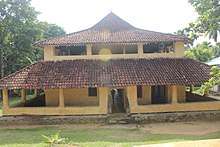Dodanthale Raja Maha Vihara
Dodanthale Raja Maha Vihara (also known as Sri Seneviratne Uposatha Raja Maha Vihara) is an historic Buddhist temple situated in Mawanella, Kegalle District, Sri Lanka. The temple is located about 4 km (2.5 mi) away from the Mawanella town. The temple has been formally recognised by the Government as an archaeological site in Sri Lanka.[1] The designation was declared on 10 November 1978 under the government Gazette number 10.[2]
| Dodanthale Raja Maha Vihara | |
|---|---|
දොඩන්තලේ රජ මහා විහාරය | |
 The image house | |
| Religion | |
| Affiliation | Buddhism |
| District | Kegalle |
| Province | Sabaragamuwa Province |
| Location | |
| Location | Mawanella, Sri Lanka |
| Geographic coordinates | 07°13′47.7″N 80°25′45.9″E |
| Architecture | |
| Type | Buddhist Temple |
| Style | Tempita Vihara |
| Completed | 1748 |
History
The temple at Dodantale was first designed by chief Adikaram Molligoda to serve as a royal palace. It is said that the ground floor of this palace was intended to use as royal audience hall while the first floor as living quarters of royalty and the third for the tooth relic of Buddha.[3] However, on second thoughts Molligoda converted the building to a Buddhist Vihara.
Image house
The temple is well known for its Image House, built in Tempita Vihara tradition. Usually the pillars used for the many of other Tempita buildings found in the country are about 3 or 4 feet in height. However the pillars used in Dodantale temple are about 6 feet in height[4] and has been built as a two storied structure where the ground floor serve as the preaching hall (Bana Maduwa) and the upper floor as the image house.[5]
There are three Buddha statues in the image house at the upper floor which is surrounded by a veranda. All the statues are curved out of timber.[6] The inner walls and the ceiling of the image house are decorated with Kandyan period murals. Among them a portrait of the Kirti Sri Rajasinha (1747-1782) wearing the Kurulu Padakkama (Bird pendant) has been identified.[7] Kurulu Padakkama is a jewel made for the Adikaram Molligoda which has a Sinhalese inscription on the reverse.[8] Also an old wide-mouthed large earthen vessel called Pathra, used to hold water or to receive offerings from worshipers, has been preserved in the Vihara premises today.[9]
References
- "Protected Monument List 2012-12-12" (PDF). Department of Archaeology. 12 December 2012. Retrieved 2 January 2017.
- "Gazette". The Gazette of the Democratic Socialist Republic of Sri Lanka. 10. 10 November 1978.
- Abhayavardhana, E. P (2002). Heritage of Sabaragamuwa: major natural, cultural, and historic sites. Sabaragamuwa Development Bank. p. 72. ISBN 9789555750776.
- "ටැම්පිට විහාර සම්ප්රදාය". Divaina. Upali Newspapers. 14 September 2016. Retrieved 11 January 2018.
සමහර ටැම්පිට විහාර වල ගල්කණු පොළව මට්ටමේ සිට අඩි 6 ක් පමණ උසින් පිහිටන අවස්ථාද ඇත. එයට කදිම නිදසුන මාවනැල්ලේ දොඩම්තලේ රජමහා විහාරය හා අම්බුළුගල රජමහා විහාරයේ පිහිටි ටැම්පිට විහාරයි. (translation = The height of stone pillars of some Tempita temples are about 6 feet from the ground. The best examples for that kind of Tempita Vihara are Mawanella Dodamthale Rajamaha Vihara and Ambulugala Rajamaha Vihara.)
- Coomaraswamy, A. K. (1908). Mediæval Sinhalese Art. Essex House Press. p. 118.CS1 maint: ref=harv (link)
- Nimal De Siva, D.P. Chandrasekara (2009). Heritage buildings of Sri Lanka#Dodanthale image house. Colombo: The national trust Sri Lanka. p. 20. ISBN 978-955-0093-01-4.CS1 maint: uses authors parameter (link)
- Coomaraswamy 1908, p. 212.
- Coomaraswamy 1908, p. 211.
- National Museums of Sri Lanka (1907). Spolia Zeylanica, Volumes 1-4. National Museums of Sri Lanka. p. 7.